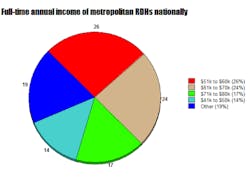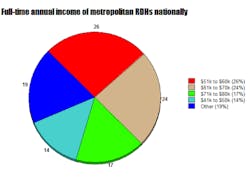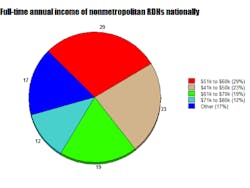RDH eVillage Salary Survey, part 1: Are annual incomes as rosy as the forecasts?
For much of the last decade, economic forecasts centered on dental hygiene as being one of the best occupations for earning excellent pay with minimal training. In addition, the profession is consistently projected as being one of the fastest growing occupations during the post-recession years, with a glowing outlook going well into the next decade and beyond.
Are dental hygiene salaries keeping pace with the rosy projections?
RDH eVillage recently asked 2,514 dental hygienists for their estimate on what they would earn during 2016. Among U.S. dental hygienists who indicated that they work full time, 978 said they expected to finish the year earning up to $70,000. Only 341 full-time dental hygienists expected to earn more than $70,000.
In contrast, the U.S. Bureau of Labor Statistics said the median annual pay for dental hygienists in 2015 was $72,330. U.S. News & World Report, which claims dental hygiene is the top “health care support job,” cited $71,520 as the median annual salary.
Based on the RDH eVillage survey, the median salary for full-time dental hygienists falls in the $51,000 to $60,000 income bracket, easily $10,000 less than what employment outlooks advocate.
This first installment of the 2016 RDH eVillage salary survey examines the projected annual income for full-time dental hygienists in 24 states. The reason that all 50 states are not reported is some states did not report enough full-time salaries. Upcoming articles about the salary survey will feature information from all 50 states.
In addition, the illustrations below do not show both “metropolitan” and “nonmetropolitan” statistics for all states. Again, in some cases, a state did not report enough full-time salaries in one or both practice locations.
Click on the states below to view the percentages of various annual income levels.
- Arizona (81% said they worked in a metropolitan area)
- California metropolitan
- California nonmetropolitan
- Colorado metropolitan
- Colorado nonmetropolitan
- Connecticut (78% said they worked in a small town or rural area)
- Florida metropolitan
- Florida nonmetropolitan
- Georgia metropolitan
- Georgia nonmetrropolitan
- Illinois (85% said they worked in a metropolitan area)
- Indiana (59% said they worked in a small town or rural area)
- Maryland (67% said they worked in a metropolitan area)
- Massachusetts metropolitan
- Massachusetts nonmetropolitan
- Michigan metropolitan
- Michigan nonmetropolitan
- Minnesota (59% said they worked in a metropolitan area)
- Missouri (57% said they worked in a metropolitan area)
- New Jersey (60% said they worked in a metropolitan area)
- New York metropolitan
- New York nonmetropolitan
- North Carolina metropolitan
- North Carolina nonmetropolitan
- Ohio metropolitan
- Ohio nonmetropolitan
- Oregon (60% said they work in a small town or rural area)
- Pennsylvania metropolitan
- Pennsylvania nonmetropolitan
- Tennessee (65% said they work in a small town or rural area)
- Texas metropolitan
- Texas nonmetropolitan
- Virginia (65% said they work in a metropolitan area)
- Washington (59% said they work in a metropolitan area)
- Wisconsin metropolitan
- Wisconsin nonmetropolitan
About the Author

Mark Hartley
Mark Hartley is the editor of RDH magazine and collaborates with Kristine Hodsdon on many of the articles for RDH eVillage, which also appear on DentistryIQ.com.


